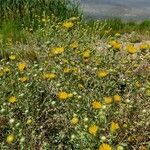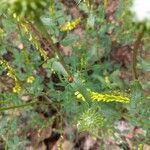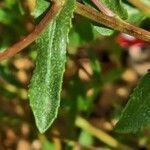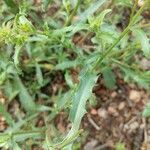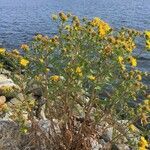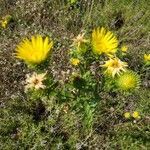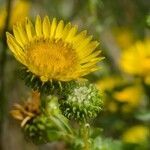Herbs biennial, perennial, or subshrubs, [10-]40-55[-100] cm tall. Stems erect, glabrous, resinous. Leaves: cauline sessile, oval, ovate, [obovate or oblong to spatulate, oblanceolate, lanceolate, or linear], 3.1-4.2 × 1.3-1.6 cm, glabrous, strongly gland-dotted, base ± clasping, margin usually crenate to serrate (teeth resin-tipped) [rarely entire], apex [obtuse to] acute. Capitula in corymbiform synflorescences, rarely solitary, 0.9-1.5 cm. Involucres broadly urceolate to hemispheric or globose, [8-20 mm in diam.]; phyllaries 5-or 6(-10)-seriate, reflexed to spreading or appressed, filiform or linear to lanceolate-linear, 4-7 mm, resinous, apex usually looped or hooked, subulate. Ray florets [absent or] (12-)24-36(-40), lamina elliptic, 7[-14] mm; disk florets 3-4 mm, limb funnelform, lobes ca. 1 mm. Achenes stramineous [or whitish, brown, or gray], [1.5-]2.8-3[-4.5] mm, faces smooth, striate or ± furrowed. Pappus of 2-4(-8) deciduous, straight or contorted to curled scales or awns [2.5-]4[-5.5] mm, shorter than disk corollas. Fl. [Jul-]Aug-Sep[-Oct].
Glabrous biennial or short-lived perennial 1–10 dm, branched at least above; lvs abundantly punctate; heads several or many, the disk 1–2 cm wide; invol bracts strongly resinous, imbricate in several series, the green tips (especially of the outer) squarrose-reflexed; rays 25–40, 7–15 mm, rarely absent; achenes 2–3 mm; pappus-awns 2–8, finely serrulate to subentire; 2n=12, 24. Open or waste places; Man. and Minn. to B.C., Nev., and Tex., and widely intr. elsewhere. July–Sept. The southwestern var. nuda (A. W. Wood) A. Gray, with discoid heads, is not a regular member of our flora. Three other vars., all radiate, occur with us:
A herb. It can grow for a few years. It has taproots. The stems are 20-80 cm tall. The leaves are oblong and have lobes or teeth. The leaves often clasp the stem. The flower heads are yellow and 2-3 cm across. They are 25-40 flowers around a yellow disk. The fruit are 4-5 ribbed dry seed heads or achenes.
